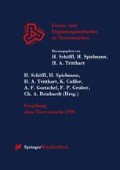Summary
The complexity of the nervous systems has to some extent inhibited the discovery, validation and application of in vitro models to neurotoxicity testing as well as the regulatory recognition of their potential usefulness in compound development. The availability of in vitro organotypic models for brain together with other systems for detecting peripheral neuropathy in vitro has, however, now facilitated recommendations for tiered systems and batteries incorporating such models as key elements. Some of the long-standing questions such as „What about the blood-brain-barrier and metabolic activation?“ can also begin to be addressed as the access to co-cultures of endothelial and liver cells with e.g. organotypic reaggregate cultures becomes available. This, together with identification of more salient in vitro endpoints with clinical relevance and better human in vivo neurotoxicological databases, will hopefully expedite regulatory acceptance of the in vitro approach, facilitate interdisciplinary prevalidation and validation work, and hopefully direct higher-level research funding to this important area of cellular toxicology.
Zusammenfassung
Der komplexe Aufbau des Nervensystems hat bis zu einem gewissen Grad die Entdeckung, die Validierung and Anwendung von in vitro-Modellen bei neurotoxikologischen Tests sowie die Anerkennung ihrer potentiellen Verwendbarkeit im Rahmen der Medikamentenentwicklung gehemmt.
Die Verfügbarkeit von organspezifischen in vitro-Modellen des Gehirns in Verbindung mit anderen Testsystemen zur Erkennung einer peripheren Neuropathie in vitro hat die Empfehlung für verknüpfte Testsysteme und -anordnungen, die solche Modelle als Schlüsselelemente beinhalten, erleichtert.
Einige der schon lange bestehenden Fragen, wie z.B.: „ Was ist mit der Blut-Hirn-Schranke und der metabolischen Aktivität?“, können jetzt mit der Erschließung der Cokulturen von Endothel- und Leberzellen mit z.B. organspezifischen reaggregierten Kulturen angegangen werden.
Dies wird, in Verbindung mit der Identifikation von weiteren hervortretenden in vitro-Endpunkten mit klinischer Relevanz und besserer neurotoxikologischer in vivo-Datenbasis im Humanbereich, hoffentlich eine akkzeptanz der in vitro-Herangehensweise und die Erleichterung von Prevalidierung und Validierung sowie eine stärkere Unterstützung dieses wichtigen Bereichs der zellulären Toxikologie mit sich bringen.
Access this chapter
Tax calculation will be finalised at checkout
Purchases are for personal use only
Preview
Unable to display preview. Download preview PDF.
Abbreviations
- CNS:
-
Central Nervous System
- PNS:
-
Periphral Nervous System
- EPA:
-
Environmental Protection Agency
- FDA:
-
Food and Drug Administration (USA)
- ECVAM:
-
European Centre for the Validation of Alternative Methods
- FRAME:
-
Fund for the Replacement of Animals in Medical Experiments (UK)
- BTS:
-
British Toxicology Society
- CMR:
-
Centre for Medicines Research (UK)
- OPIDN:
-
Organophosphate Induced Delayed Neuropathy
- ATLA:
-
Alternatives to Laboratory Animals (Journal of FRAME)
- DRG:
-
Dorsal Root Ganglion
- GFAP:
-
Glial Fibrillary Azidic Protein
- EC:
-
Endothelial Cell
References
Atterwill C.K., Brain reaggregate cultures in neurotoxicological investigations: studies with cholinergic neurotoxins, ATLA, 16, 221–230, 1989
Atterwill C.K. et al., In vitro neurotoxicity testing, ECVAM Workshop Report No 3, ATLA, 22, 250–362, 1994
Bystry R.S, Fox R.M, Atterwill C.K., Development of a novel in vitro blood brain barrier using whole rat brain reaggregates and rat-brain derived endothelial cells, Human amp; Exp Toxicology, 1995
Cookson M. and Pentreath V., Alterations in the glial fibrillary acidic protein content of primary astrocyte cultures for evaluation of glial cell toxicity, Toxicol In Vitro, 8, 351–359, 1994
Purcell W. and Atterwill C.K., Mast cells in Neuroimmune Function: Neurotoxicological and neuropharmacological perspectives, Neurochemical Research, 20 (5), 521–532, 1995
Rowles T.K., Song X., Ehrich M., Identification of endpoints affected by exposure of human neuroblastoma cells to neuroticants at concentrations below those that affect cell viability, In Vitro Toxicology, 8, 3–13, 1995
Silver R., Silverman A.-J., Vithovic L., Lederhendler I., Mast cells in the brain: evidence amp; functional significance, TINS, 19 (1), 25–31, 1996
Thomas K., McAuslane j., Lumley C, Pharmaceuticlas acting on the nervous system — how frequently do they cause central nervous system exciting, Proceedings of BTS Meeting (Poster) 21–23 Sept. 1994, Edinburgh, 1994
Veronesi B., In vitro screening batteries for neurotoxicants, Neurotoxicology, 13, 185–196, 1992
Williams S.P. et al., Phase I of an in vitro neurotoxicology validation trial, Toxicol In Vitro, 8 (4), 799–802, 1994
Williams S.P., O’Brien S., Whitmore K., Purcell W.M., Cookson M.R., Mead C, Pentreath V.W., Atterwill C.K., An in vitro neurotoxicity testing scheme; evaluation of cytotoxicity determinations in neural amp; non-neural cells, In vitro Toxicology, 9 (1), 83–92, 1996
Editor information
Editors and Affiliations
Rights and permissions
Copyright information
© 1997 Springer-Verlag/Wien
About this paper
Cite this paper
Atterwill, C. (1997). Current trends for the assessment of neurotoxicity in vitro. In: Schöffl, H., et al. Forschung ohne Tierversuche 1996. Ersatz- und Ergänzungsmethoden zu Tierversuchen. Springer, Vienna. https://doi.org/10.1007/978-3-7091-6833-2_6
Download citation
DOI: https://doi.org/10.1007/978-3-7091-6833-2_6
Publisher Name: Springer, Vienna
Print ISBN: 978-3-211-82869-4
Online ISBN: 978-3-7091-6833-2
eBook Packages: Springer Book Archive

